Everything you always
wanted to know about creative translation
wanted to know about creative translation
What is transcreation?
Transcreation is a mix of two services: translation and copywriting. You could also think of it as copywriting in another language. The text is adapted to make sure that it is culturally appropriate for the target audience. This means different phrases and wordplay might be used in the target language, but the text achieves the same effect as the original.
Transcreation is perfect for all those texts that aim to boost your image as well as those designed to inspire or motivate your customers, staff, and partners.
What’s the difference between transcreation and translation?
Translation and transcreation are two different ways of rendering content in another language. Deciding which service is right for you will depend on the purpose of the text itself.
Translation involves transferring text verbatim into another language while staying as close to the original as possible. Translations are suitable for informational texts, e.g. technical manuals, annual reports, or legal texts.
Transcreation, on the other hand, is about expressing the message in a new language, so that the emotional impact and imagery are the same for the new target audience. The source text serves as a guide, but focus is placed on the unique cultural characteristics and customer expectations in the target market. Transcreation is ideal for advertising copy and other content that should inspire readers to take action, or texts that are important for a company’s brand image.
How do I know if I need a transcreation? Is it only relevant for certain sectors or types of text?
Transcreation should always be used for texts that are relevant to a company’s image and/or address a target audience directly. This could include:
- advertising materials (e.g. brochures, ads, slogans)
- PR copy (e.g. press releases or interviews)
- Corporate texts (e.g. a company’s website, blog articles, job listings).
Here’s a short checklist to help you decide whether you need transcreation services:
- Is the text relevant for your corporate image?
- Is the text designed to persuade your customers to do something, e.g. to make a purchase?
- Is the text intended for a specific audience?
If you answered “yes” to any of the above questions, you probably need a transcreation. But if you still aren’t sure, just get in touch with us. We’ll be happy to help you decide.
How much does transcreation cost?
The cost depends on the type of text involved, its complexity, and your exact needs. That is why we calculate our fees on a project-by-project basis. Our quote includes our briefing, transcreation of the text, and any revisions, so there are no unexpected surprises. We would be happy to send you a personal, no-obligation quote for your project. When you get in touch, please let us know what type of text you need transcreated, where you plan to have it published (e.g. online or in a magazine), and when it should be ready. We’ll handle the rest.
How long does transcreation take?
Strange but true: things that seem easy are usually the result of countless hours of hard work. Take taglines, for example. They boil down the essence of a marketing campaign into one clear phrase—which should be as catchy as possible. And because how it is said is just as important as what is said, it’s impossible to simply translate a tagline. In transcreation, we have to reinvent the how—by finding another way to convey the underlying message. Sometimes it can take four or five hours to transcreate a 5-word tagline. Conversely, longer texts that require less behind-the-scenes creative work are often much quicker.
What documentation do I need to provide?
We need the text that you need translated, of course! And we’ll also ask you for as much information about your company, brand, and portfolio as possible: What benefits do your products offer? How is your company positioned on the market? What is your target audience and how would you like them to view your brand? The more details you can provide, the better. We can discuss most of the key points during our initial meeting or phone call.
How do you know that your transcreation is good and will speak to the right target audience?
To make sure that the messaging has the right effect on your audience, we approach things the same way that your own marketing team would. We compile an overview of your company and your portfolio. Then we take a look at the German market. What matters to your German-speaking target group? Which products are likely to compete with yours? We use this information to find the right brand voice for your German texts and to ensure that your message hits the mark.
Is there any way to measure how successful a transcreation is? Are there any studies that detail how transcreation can benefit a company in quantitative terms, e.g. boost revenue?
Communication is one of many elements that contribute to a company’s success, and it’s hard to quantify its effectiveness. However, in today’s world, brand recognition and trustworthiness are key to helping a company stand out from the competition. To make sure your brand stands out, your content and marketing materials need to be concise, punchy, and tailored to your target audience. It’s not just about the content, but about how the message is conveyed—and that’s exactly what transcreation is all about.
I don’t speak German. How can I tell if the transcreation is any good?
Upon request, we can provide you with a literal back-translation of our transcreated text and discuss it with you. For types of text where we need to deviate significantly from the original (e.g. taglines, slogans), we always create several versions (and relevant back-translations, if needed) and discuss them with you.
I often get translations back that are accurate as far as the content goes, but they don’t sound quite right. Why is that?
We get asked this question a lot. The problem almost always occurs when a text that was meant to be persuasive, rather than just informative, is simply translated. The content is transferred into the new language, but wordplay, emotions, nuances, and the underlying aim are left behind. The result is a text that might be “accurate,” but sounds awkward and isn’t as convincing as the original. Transcreation is the answer to this problem!
My company has already invested a great deal in brand and product development, as well as communication. We have in-depth knowledge of our target audience and the benefits of our services/products. Many highly skilled individuals have already devoted many hours to perfecting our content and marketing materials. All that is left is to have them translated. Why should I invest even more in transcreation?
Brand messaging takes place between the lines. A product’s benefits are subtly tied to specific emotions, and a company’s values are expressed through a certain style of speech (or writing, as the case may be). This all gets lost when a text is translated literally. By choosing transcreation, you ensure that all the elements your team painstakingly designed during the branding process have the desired effect on your German audience, as well.
Does Saramatik also offer sample translations?
We would be happy to provide a short, paid sample translation upon request to help you understand how we can help add value to your German communications. That way, you’ll get to see how we work, and you’ll also be able to get a better idea of the time and costs required for the project.


